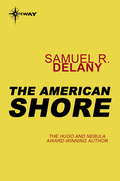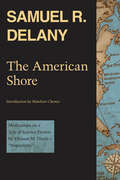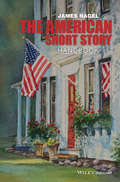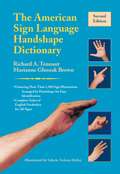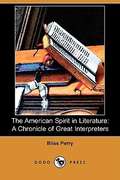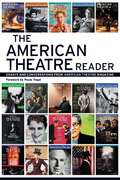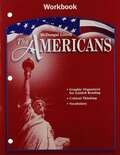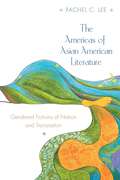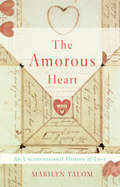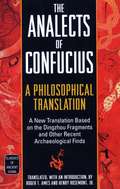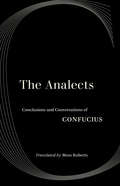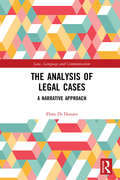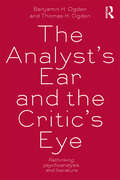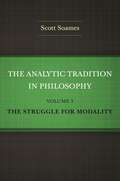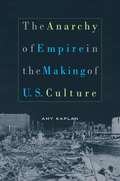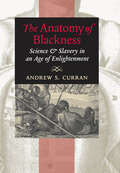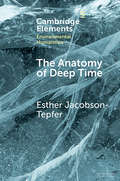- Table View
- List View
The American Roadside in Émigré Literature, Film, and Photography: 1955–1985 (Studies in Mobilities, Literature, and Culture)
by Elsa CourtThe American Roadside in Émigré Literature, Film, and Photography: 1955–1985 traces the origin of a postmodern iconography of mobile consumption equating roadside America with an authentic experience of the United States through the postwar road narrative, a narrative which, Elsa Court argues, has been shaped by and through white male émigré narratives of the American road, in both literature and visual culture. While stressing that these narratives are limited in their understanding of the processes of exclusion and unequal flux in experiences of modern automobility, the book works through four case studies in the American works of European-born authors Vladimir Nabokov, Robert Frank, Alfred Hitchcock, and Wim Wenders to unveil an early phenomenology of the postwar American highway, one that anticipates the works of late-twentieth-century spatial theorists Jean Baudrillard, Michel Foucault, and Marc Augé and sketches a postmodern aesthetic of western mobility and consumption that has become synonymous with contemporary America.
The American Shore
by Samuel R. DelanyIn the course of his considerations, Samuel R. Delany poses a theory of discourse and explores how the reading of various rhetorical turns, some science fictional, some not, is shifted by science fictional understanding.
The American Shore: Meditations on a Tale of Science Fiction by Thomas M. Disch—"Angouleme"
by Thomas M. Disch Samuel R. DelanyFrom the four-time Nebula Award–winning author, a keystone text in literary theory and science fiction analyzing a 1972 work of dystopian fiction.The American Shore: Meditations on a Tale of Science Fiction by Thomas M. Disch—&“Angouleme&” was first published in 1978 to the intense interest of science fiction readers and the growing community of SF scholars. Recalling Nabokov&’s commentary on Pushkin&’s Eugene Onegin, Roland Barthes&’s commentary on Balzac&’s Sarazine, and Grabinier&’s reading of The Heart of Hamlet, this book-length essay helped prove the genre worthy of serious investigation. The American Shore is the third in a series of influential critical works by Samuel R. Delany, beginning with The Jewel-Hinged Jaw and Starboard Wine, first published in the late seventies and reissued over the last five years by Wesleyan University Press, which helped win Delany a Pilgrim Award for Science Fiction Scholarship from the Science Fiction Research Association of America. This edition includes the author&’s corrected text as well as a new introduction by Delany scholar Matthew Cheney.&“The American Shore is an important offering in the history of science fiction criticism, rich with Delany&’s poetic skills and insight as a tremendous, formidable reader. It is a one of a kind book, really, and very clearly attempts a genre of its own.&” —Louis Chude-Sokei, University of Washington&“Delany&’s dive over and between the lines of &“Angouleme&” stands as a model of thought about all the signs and languages that produce and obscure our lives. No great text ever ends if there are still readers to read it and reread it, to diffuse it and re-fuse it, reveling in the possibilities of polysemy and dissemination.&” —Matthew Cheney, from the introduction
The American Short Story Handbook (Wiley Blackwell Literature Handbooks)
by James NagelThis is a concise yet comprehensive treatment of the American short story that includes an historical overview of the topic as well as discussion of notable American authors and individual stories, from Benjamin Franklin’s “The Speech of Miss Polly Baker” in 1747 to “The Joy Luck Club”. Includes a selection of writers chosen not only for their contributions of individual stories but for bodies of work that advanced the boundaries of short fiction, including Washington Irving, Sarah Orne Jewett, Stephen Crane, Jamaica Kincaid, and Tim O’Brien Addresses the ways in which American oral storytelling and other narrative traditions were integral to the formation and flourishing of the short story genre Written in accessible and engaging prose for students at all levels by a renowned literary scholar to illuminate an important genre that has received short shrift in scholarly literature of the last century Includes a glossary defining the most common terms used in literary history and in critical discussions of fiction, and a bibliography of works for further study
The American Sign Language Handshape Dictionary
by Richard A. Tennant Marianne Gluszak BrownThis unique reference can help users locate a sign whose meaning they have forgotten, or help them find the meaning of a new sign they have just seen for the first time. It organizes more than 1,900 ASL signs by 40 basic handshapes and includes detailed descriptions on how to form these signs to represent the different English words that they might mean. Users can begin to track down a sign by determining whether it is formed with one hand or two. Further distinctions of handshape, palm orientation, location, movement, and nonmanual signals help them pinpoint their search while also refining their grasp of ASL syntax and grammar. A complete English word index provides the option of referring to an alphabetical listing of English terms to locate an equivalent sign or choice of signs. This dictionary features: More than 1,900 sign illustrations, organized by handshape Complete index of English vocabulary for all signs An introduction to Deaf culture and ASL structure The American Sign Language Handshape Dictionary is a one-of-a-kind resource for learning ASL and enhancing communication skills in both ASL and English.
The American Spirit in Literature: A Chronicle of Great Interpreters
by Bliss PerryA unique set of short stories, poems and novels from the late 19th to early 20th centuries. From tales of love, life and heartbreaking loss to humorous stories of ghost encounters, these volumes captivate the imaginations of readers young and old. <P> <P> Included in this collection are a variety of dramatic and spirited poems that contemplate the mysteries of life and celebrate the wild beauty of nature. This is a history of American literature and writers that includes chapters on colonial literature, the knickerbockers, the transcendentalists, Emerson, Thoreau, Whitman, Poe and many others as well.
The American Theatre Reader
by Staff of American Theatre MagazineIn celebration of American Theatre's twenty-fifth anniversary, the editors of the nation's leading theater magazine have chosen their best essays and interviews to provide an intimate look at the people, plays, and events that have shaped the American theater over the past quarter-century. Over two hundred artists, critics, and theater professionals are gathered in this one-of-a-kind collection, from the visionaries who conceived of a diverse and thriving national theater community, to the practitioners who have made that dream a reality. The American Theatre Reader captures their wide-ranging stories in a single compelling volume, essential reading for theater professionals and theatergoers alike.Partial contents include:Interviews with Edward Albee, Anne Bogart, Peter Brook, Lorraine Hansbury, Lillian Hellman, Jonathan Larson, David Mamet, Arthur Miller, Joseph Papp, Will Power, Bartlett Scher, Sam Shepard, Tom Stoppard, Luis Valdez, Paula Vogel, August Wilson, and others.Essays by Eric Bentley, Eric Bogosian, Robert Brustein, Christopher Durang, Oskar Eustis, Zelda Fichandler, Eva La Gallienne, Vaclav Havel, Danny Hoch, Tina Howe, David Henry Hwang, Naomi Iizuki, Adrienne Kennedy, Tony Kushner, Kristin Linklater, Todd London, Robert MacNeil, Des McAnuff, Conor McPherson, Marsha Norman, Suzan-Lori Parks, Hal Prince, Phylicia Rashad, Frank Rich, José Rivera, Alan Schneider, Marian Seldes, Wallace Shawn, Anna Deavere Smith, Molly Smith, Diana Son, Wole Soyinka, and many others.
The American Tradition: The Emc Write-in Reader
by Laurie SkibaBook by Skiba: The American Tradition: The Emc Write-in Reader
The American West (Great Minds Wit & Wisdom #Grade 2 Module 2:)
by Ann Brigham Lauren Chapalee Lorraine GriffithNIMAC-sourced textbook
The American West and Its Interpreters: Essays on Literary History and Historiography
by Richard W. EtulainDistinguished historian Richard W. Etulain brings together a generous selection of essays from his sixty-year career as a specialist on the US West in this essential volume. Each essay provides an invaluable overview of the rise of western literary history and historiography—including insightful evaluations of individual historians—revealing summaries of regional literature and discussions of western stories yet to be told. Together these writings furnish readers with useful considerations of important subjects about the American West. All those interested in the American West and its interpreters will find these illuminative moments of literary history and historiography especially appealing.
The American West: Assessment Pack (Great Minds Wit & Wisdom #Grade 2 Module 2)
by Great MindsNIMAC-sourced textbook
The Americanization of the British Press, 1830s–1914
by Joel H. WienerThe first book to compare and contrast the rise of mass circulation press in Britain and America. It provides insights into the origins of tabloid journalism and explores a range of cross-cultural and literary issues, tracing the history of key newspapers and the careers of influential journalists such as Bennett, Russell, Harmsworth and Pulitzer.
The Americans: Workbook
by Holt McdougalThe Americans, Grades 9-12 Workbook: Mcdougal Littell the Americans
The Americas of Asian American Literature: Gendered Fictions of Nation and Transnation
by Rachel C. LeeDrawing on a wide array of literary, historical, and theoretical sources, Rachel Lee addresses current debates on the relationship among Asian American ethnic identity, national belonging, globalization, and gender. Lee argues that scholars have traditionally placed undue emphasis on ethnic-based political commitments--whether these are construed as national or global--in their readings of Asian American texts. This has constrained the intelligibility of stories that are focused less on ethnicity than on kinship, family dynamics, eroticism, and gender roles. In response, Lee makes a case for a reconceptualized Asian American criticism that centrally features gender and sexuality. Through a critical analysis of select literary texts--novels by Carlos Bulosan, Gish Jen, Jessica Hagedorn, and Karen Yamashita--Lee probes the specific ways in which some Asian American authors have steered around ethnic themes with alternative tales circulating around gender and sexual identity. Lee makes it clear that what has been missing from current debates has been an analysis of the complex ways in which gender mediates questions of both national belonging and international migration. From anti-miscegenation legislation in the early twentieth century to poststructuralist theories of language to Third World feminist theory to critical studies of global cultural and economic flows, The Americas of Asian American Literature takes up pressing cultural and literary questions and points to a new direction in literary criticism.
The Amorous Heart: An Unconventional History of Love
by Marilyn YalomAn eminent scholar unearths the captivating history of the two-lobed heart symbol from scripture and tapestry to T-shirts and text messages, shedding light on how we have expressed love since antiquityThe symmetrical, exuberant heart is everywhere: it gives shape to candy, pendants, the frothy milk on top of a cappuccino, and much else. How can we explain the ubiquity of what might be the most recognizable symbol in the world?In The Amorous Heart, Marilyn Yalom tracks the heart metaphor and heart iconography across two thousand years, through Christian theology, pagan love poetry, medieval painting, Shakespearean drama, Enlightenment science, and into the present. She argues that the symbol reveals a tension between love as romantic and sexual on the one hand, and as religious and spiritual on the other. Ultimately, the heart symbol is a guide to the astonishing variety of human affections, from the erotic to the chaste and from the unrequited to the conjugal.
The Analects of Confucius: A Philosophical Translation
by Jr. Roger T. Ames Henry Rosemont"To quietly persevere in storing up what is learned, to continue studying without respite, to instruct others without growing weary--is this not me?"--ConfuciusConfucius is recognized as China's first and greatest teacher, and his ideas have been the fertile soil in which the Chinese cultural tradition has flourished. Now, here is a translation of the recorded thoughts and deeds that best remember Confucius--informed for the first time by the manuscript version found at Dingzhou in 1973, a partial text dating to 55 BCE and only made available to the scholarly world in 1997. The earliest Analects yet discovered, this work provides us with a new perspective on the central canonical text that has defined Chinese culture--and clearly illuminates the spirit and values of Confucius.Confucius (551-479 BCE) was born in the ancient state of Lu into an era of unrelenting, escalating violence as seven of the strongest states in the proto-Chinese world warred for supremacy. The landscape was not only fierce politically but also intellectually. Although Confucius enjoyed great popularity as a teacher, and many of his students found their way into political office, he personally had little influence in Lu. And so he began to travel from state to state as an itinerant philosopher to persuade political leaders that his teachings were a formula for social and political success. Eventually, his philosophies came to dictate the standard of behavior for all of society--including the emperor himself.Based on the latest research and complete with both Chinese and English texts, this revealing translation serves both as an excellent introduction to Confucian thought and as an authoritative addition to sophisticated debate.From the Trade Paperback edition.
The Analects: Conclusions and Conversations of Confucius
by ConfuciusFor anyone interested in China—its past, its present, and its future—the Analects (Lunyu) is a must-read. This new translation by renowned East Asian scholar Moss Roberts will offer a fresh interpretation of this classic work, sharpening and clarifying its positions on ethics, politics, and social organization. While no new edition of the Analects will wholly transform our understanding of Confucius’s teachings, Roberts’s translation attends to the many nuances in the text that are often overlooked, allowing readers a richer understanding of Confucius’ historic and heroic attempt to restore order and morality to government. This edition of the Analects features a critical introduction by the translator as well as notes on key terms and historical figures, a topical index, and suggestions for further reading in recent English and Chinese scholarship to extend the rich contextual background for his translation. This ambitious new edition of the Analects will enhance the understanding of specialists and newcomers to Confucius alike.
The Analysis of Legal Cases: A Narrative Approach (Law, Language and Communication)
by Flora Di DonatoThis book examines the roles played by narrative and culture in the construction of legal cases and their resolution. It is articulated in two parts. Part I recalls epistemological turns in legal thinking as it moves from theory to practice in order to show how facts are constructed within the legal process. By combining interdisciplinary paradigms and methods, the work analyses the evolution of facts from their expression by the client to their translation within the lawyer-client relationship and the subsequent decision of the judge, focusing on the dynamic activity of narrative constuction among the key actors: client, lawyer and judge. Part II expands the scientific framework toward a law-and-culture-oriented perspective, illustrating how legal stories come about in the fabric of the authentic dimensions of everyday life. The book stresses the capacity of laypeople, who in this activity are equated with clients, to shape the law, dealing not just with formal rules, but also with implicit or customary rules, in given contexts. By including the illustration of cases concerning vulnerable clients, it lays the foundations for developing a socio-clinical research programme, whose aims including enabling lay and expert actors to meet for the purposes of improving forms of collective narrations and generating more just legal systems.
The Analyst's Ear and the Critic's Eye: Rethinking psychoanalysis and literature
by Thomas H. Ogden Benjamin H. OgdenThe Analyst‘s Ear and the Critic‘s Eye is the first volume of literary criticism to be co-authored by a practicing psychoanalyst and a literary critic. The result of this unique collaboration is a lively conversation that not only demonstrates what is most fundamental to each discipline, but creates a joint perspective on reading literature that ne
The Analytic Tradition in Philosophy, Volume 3: The Struggle for Modality
by Scott SoamesAn in-depth history of modal logic in analytic philosophy, from a leading philosopher of languageThis is the third of five volumes of a definitive history of analytic philosophy from the invention of modern logic in 1879 to the end of the twentieth century. Scott Soames, a leading philosopher of language and historian of analytic philosophy, provides the fullest and most detailed account of the analytic tradition yet published, one that is unmatched in its chronological range, topics covered, and depth of treatment. Focusing on the major milestones and distinguishing them from detours, Soames gives a seminal account of where the analytic tradition has been and where it appears to be heading.Volume 3 explains the most important achievement in the analytic tradition in the twentieth century—the rise and development of the epistemic and metaphysical modalities of necessity, possibility, and conceivability—and how it opened new vistas for the understanding of mind, meaning, and metaphysics. At the center of the story is Saul Kripke, who generated new modal systems and their open-ended philosophical applications, and his undergraduate teacher, W.V.O. Quine, who rejected the modalities plus our notions of linguistic meaning and reference. Part 1 traces the rise of modal logic from C. I. Lewis&’s unhappiness with Alfred North Whitehead and Bertrand Russell&’s Principia Mathematica, through Lewis&’s modal S-systems, Ruth Marcus&’s proof-theoretic quantified modal logic, Rudolph Carnap&’s Meaning and Necessity, and Kripke&’s logical and philosophical breakthrough. Part 2 chronicles Quine&’s rejection of meaning, necessity, synonymy, and reference. Part 3 assesses the philosophical framework provided by Kripke&’s Naming and Necessity, separating its revolutionary insights from its unsolved problems.
The Anarchy of Empire in the Making of U.S. Culture (Convergences)
by Amy KaplanThe United States has always imagined that its identity as a nation is insulated from violent interventions abroad, as if a line between domestic and foreign affairs could be neatly drawn. Yet this book argues that such a distinction, so obviously impracticable in our own global era, has been illusory at least since the war with Mexico in the mid-nineteenth century and the later wars against Spain, Cuba, and the Philippines. In this book, Amy Kaplan shows how U.S. imperialism--from "Manifest Destiny" to the "American Century"--has profoundly shaped key elements of American culture at home, and how the struggle for power over foreign peoples and places has disrupted the quest for domestic order. The neatly ordered kitchen in Catherine Beecher's household manual may seem remote from the battlefields of Mexico in 1846, just as Mark Twain's Mississippi may seem distant from Honolulu in 1866, or W. E. B. Du Bois's reports of the East St. Louis Race Riot from the colonization of Africa in 1917. But, as this book reveals, such apparently disparate locations are cast into jarring proximity by imperial expansion. In literature, journalism, film, political speeches, and legal documents, Kaplan traces the undeniable connections between American efforts to quell anarchy abroad and the eruption of such anarchy at the heart of the empire.
The Anatomy of Blackness: Science and Slavery in an Age of Enlightenment
by Andrew S. Curran2012 Outstanding Academic Title, Choice MagazineThis volume examines the Enlightenment-era textualization of the Black African in European thought. Andrew S. Curran rewrites the history of blackness by replicating the practices of eighteenth-century readers. Surveying French and European travelogues, natural histories, works of anatomy, pro- and anti-slavery tracts, philosophical treatises, and literary texts, Curran shows how naturalists and philosophes drew from travel literature to discuss the perceived problem of human blackness within the nascent human sciences, describes how a number of now-forgotten anatomists revolutionized the era’s understanding of black Africans, and charts the shift of the slavery debate from the moral, mercantile, and theological realms toward that of the "black body" itself. In tracing this evolution, he shows how blackness changed from a mere descriptor in earlier periods into a thing to be measured, dissected, handled, and often brutalized. Penetrating and comprehensive, The Anatomy of Blackness shows that, far from being a monolithic idea, eighteenth-century Africanist discourse emerged out of a vigorous, varied dialogue that involved missionaries, slavers, colonists, naturalists, anatomists, philosophers, and Africans themselves.
The Anatomy of Deep Time: Rock Art and Landscape in the Altai Mountains of Mongolia (Elements in Environmental Humanities)
by Esther Jacobson-TepferPetroglyphic rock art in three valleys of Mongolia's Altai Mountains reveals the anatomy of deep time at the boundary between Central and North Asia. Inscribed over a period of twelve millennia, its subject matter, styles, and manner of execution reflect the constraints of changing geology, climate, and vegetation. These valleys were created and shaped by ancient glaciers. Analysis of their physical environment, projected from the deep past to the present, begins to explain the rhythm of cultural manifestations: where rock art appears, when it disappears, and why. The material and this remote arena offer an ideal laboratory to study the intersection of prehistoric culture and paleoenvironment.

